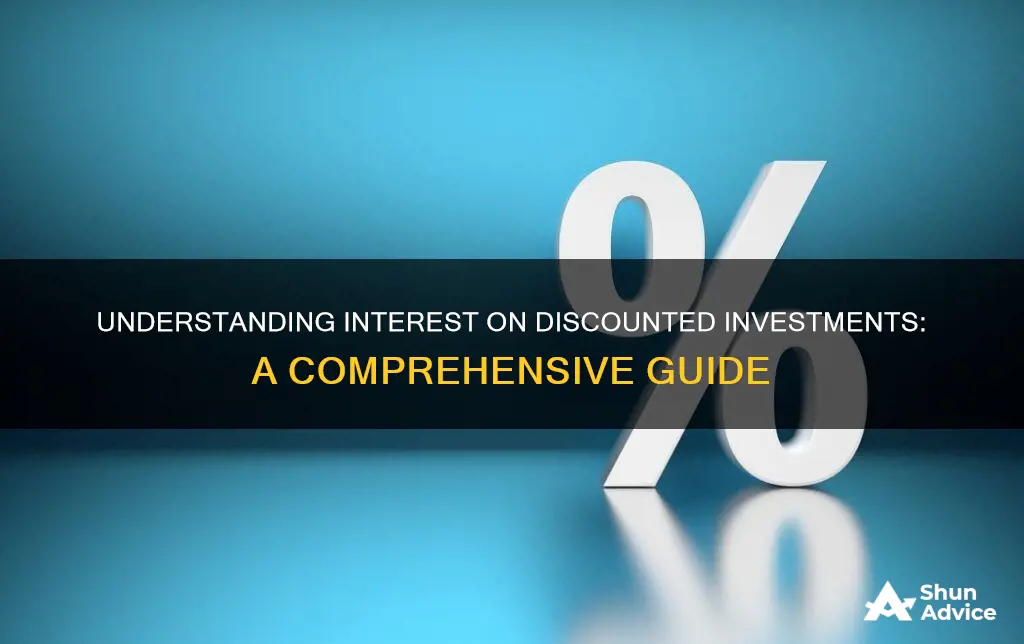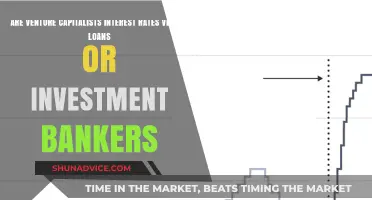
When investing in a discount instrument, understanding how interest is paid is crucial for managing your financial portfolio effectively. Interest on a discount investment is typically calculated and paid at maturity, which is the date when the investment fully matures and the principal amount is returned to the investor. This differs from regular savings accounts or bonds, where interest is often paid out periodically. The interest earned on a discount investment is based on the difference between the face value (the amount the investment will be worth at maturity) and the purchase price (the amount you pay for the investment). This difference is known as the discount, and it represents the interest that has been discounted upfront. As the investment approaches maturity, the discount narrows, and the interest earned increases, providing a unique way to grow your savings.
What You'll Learn
- Discount Calculation: Interest is calculated as the difference between the face value and the purchase price
- Compounding Frequency: Interest can be paid annually, semi-annually, or continuously
- Maturity Date: Interest is paid on the investment until the maturity date
- Tax Implications: Interest income may be taxable, depending on the jurisdiction
- Early Redemption: Interest can be paid if the investment is redeemed early

Discount Calculation: Interest is calculated as the difference between the face value and the purchase price
When an investment is purchased at a discount, the interest earned is calculated based on the difference between the face value (the original value of the investment at maturity) and the purchase price (the price at which the investment is bought). This concept is fundamental to understanding how interest is paid on discount investments.
Let's break it down further: Imagine you buy a bond for $900, and the bond's face value is $1,000. The difference between the face value and the purchase price is $100. This $100 represents the interest earned on the investment. The interest rate for this investment can be calculated by dividing the interest earned by the purchase price, which in this case would be 100/900, or approximately 11.11%.
This method of calculating interest is particularly useful for investors as it allows them to understand the true return on their investment, especially when comparing different investment options. By considering the discount, investors can make more informed decisions about the profitability of their purchases.
For example, if an investor buys a bond at a discount of $500 with a face value of $1,000, the interest earned would be $500. This is a straightforward way to calculate the interest, and it highlights the importance of understanding the relationship between the purchase price and the face value in discount investments.
In summary, the calculation of interest on a discount investment is a simple yet powerful tool for investors. By understanding this concept, investors can better assess the potential returns and make more strategic investment choices. It is a key aspect of financial literacy and can significantly impact investment strategies.
Understanding Taxability of Investment Interest Expenses: A Comprehensive Guide
You may want to see also

Compounding Frequency: Interest can be paid annually, semi-annually, or continuously
The concept of compounding frequency is crucial when understanding how interest is calculated and paid on a discount investment. This frequency determines how often the interest is compounded, which directly impacts the final amount received by the investor. There are three primary compounding frequencies: annually, semi-annually, and continuously. Each of these methods has its own unique implications for the growth of the investment.
Annual compounding is the most straightforward approach. Interest is calculated and added to the principal once every year. This method is simple to understand and implement, making it a popular choice for many investors. For example, if you invest $1,000 at an annual interest rate of 5%, and the interest is compounded annually, you will earn $50 in interest each year, and your investment will grow to $1,050 at the end of the year. This process repeats annually, ensuring a steady growth rate.
Semi-annual compounding occurs twice a year, providing more frequent interest calculations. This method can be advantageous as it allows for slightly higher returns compared to annual compounding. For instance, with the same $1,000 investment and a 5% interest rate, semi-annual compounding would result in a smaller interest amount each time, but the total interest earned over the year would be slightly higher due to the more frequent compounding periods. This increased frequency can lead to a more substantial final amount over time.
Continuous compounding is a more complex process where interest is calculated and added to the principal an infinite number of times per year. This method assumes that interest is compounded continuously, resulting in exponential growth. The formula for continuous compounding is more intricate, taking into account the number of compounding periods per year. This approach is particularly useful for understanding the long-term growth potential of an investment, as it provides a more accurate representation of the investment's value over extended periods.
Understanding the impact of compounding frequency is essential for investors as it directly influences the overall return on their investments. By choosing the appropriate compounding frequency, investors can optimize their returns and make more informed decisions about their financial strategies. Whether it's the simplicity of annual compounding, the slightly higher returns of semi-annual compounding, or the exponential growth of continuous compounding, each method offers a unique way to grow an investment over time.
Maximizing Returns: How Multiple Investments Can Boost Your Interest Earnings
You may want to see also

Maturity Date: Interest is paid on the investment until the maturity date
When an investor purchases a discount investment, they essentially buy it at a price lower than its face value. This discount is the interest that the investor will earn over the life of the investment until it reaches its maturity date. The maturity date is a crucial aspect of this investment strategy, as it determines when the investment will mature and the investor will receive the full face value of the investment, along with the accrued interest.
Interest payments on a discount investment are typically made periodically, such as annually, semi-annually, or quarterly, depending on the terms of the investment. These payments are calculated based on the discount amount and the time remaining until the maturity date. As the investment approaches maturity, the interest earned per period will decrease because the principal amount (the face value of the investment) is getting closer to being fully paid.
For example, consider a $1,000 bond with a face value of $1,000 and a maturity date of 5 years. If the bond is purchased at a discount of 5%, the investor pays $950 for the bond. The interest earned each year will be calculated as a percentage of the $950 investment, and this interest will be paid out until the maturity date. As the bond gets closer to maturity, the interest payments will gradually increase, but they will always be less than the face value of $1,000.
The key advantage of this strategy is that investors can earn a higher effective interest rate over the life of the investment compared to purchasing it at face value. This is because the investor is essentially paying less for the investment upfront and earning interest on the full face value over time. As a result, the investor benefits from the power of compounding, where the interest earned each period is added to the principal, and subsequent interest is calculated on this larger amount.
In summary, the maturity date is a critical factor in understanding how interest is paid on a discount investment. Investors can take advantage of this strategy to maximize their returns, especially in low-interest-rate environments, by purchasing investments at a discount and earning interest on the full face value until maturity.
Interest Rate Hikes: The Debt Investment Conundrum
You may want to see also

Tax Implications: Interest income may be taxable, depending on the jurisdiction
Interest income from discount investments can have significant tax implications, and understanding these is crucial for investors to ensure compliance and optimize their financial strategies. The tax treatment of interest income varies depending on the country or region, and it's essential to be aware of these differences to avoid any surprises.
In many jurisdictions, interest income is generally taxable as ordinary income. This means that any interest earned from a discount investment will be subject to income tax, which is typically calculated based on the investor's overall income for the tax year. For example, if an investor purchases a bond at a discount and sells it at a profit, the interest income realized from the discount would be included in their taxable income, and they would owe taxes on that amount.
The tax rate applied to interest income can vary widely. In some countries, it may be taxed at the investor's marginal tax rate, which can be relatively high, especially for high-income earners. In contrast, other jurisdictions might offer more favorable tax rates for interest income, especially for long-term investments. Understanding the local tax laws and rates is essential to accurately calculate and report interest income.
Additionally, certain jurisdictions provide tax incentives or exemptions for specific types of investments. For instance, some countries may offer tax breaks for investments in government bonds or provide reduced tax rates for long-term capital gains. These incentives can significantly impact the net interest income an investor receives, making it essential to research and consider the specific tax laws in the relevant region.
Investors should also be mindful of the timing of interest payments and their impact on tax liability. Interest income is typically reported on an annual basis, and the tax rules may vary depending on whether the interest is paid annually, semi-annually, or at other intervals. Proper record-keeping and understanding the tax regulations can help investors ensure they are meeting their tax obligations accurately.
Interest Rate Hikes: Unlocking Investment Potential
You may want to see also

Early Redemption: Interest can be paid if the investment is redeemed early
When an investment is purchased at a discount, it means the buyer pays less than the face value of the security. This is a common practice in the financial market, especially for bonds. The seller of the bond (the issuer) benefits from this arrangement as they receive a lower upfront payment but still earn interest over the life of the bond. Interest on a discount investment is calculated and paid in a specific way, and one of the key aspects is early redemption.
Early redemption occurs when the investor decides to sell or redeem the investment before its maturity date. This is often done to take advantage of market conditions or to secure a profit. In the context of a discount investment, early redemption can result in the investor receiving interest payments even before the bond reaches its full maturity. The interest earned on a discount investment is typically calculated as a simple interest rate, which is applied to the original face value of the bond. When the bond is redeemed early, the investor is entitled to a portion of this interest, which is calculated based on the time the investment was held.
The process of early redemption and interest payment involves a few steps. Firstly, the investor must notify the issuer or the financial institution holding the bond about their intention to redeem it early. This notice period can vary depending on the terms of the investment. Once the notice is given, the issuer calculates the interest accrued up to the redemption date. This interest is then paid to the investor, along with the principal amount they initially invested. The formula for calculating this interest is straightforward: it is the product of the face value, the discount rate, and the time period (in years) from the purchase date to the redemption date.
For example, let's say an investor buys a bond with a face value of $1,000 at a discount of 5%, paying only $950. If the bond is redeemed after 6 months, the interest earned would be calculated as follows: Interest = Face Value * Discount Rate * Time = $1,000 * 0.05 * 0.5 = $25. So, the investor would receive $25 in interest, along with the $950 principal, totaling $975. This demonstrates how early redemption can benefit investors by providing interest payments even before the investment's maturity.
Understanding the concept of early redemption and its impact on interest payment is crucial for investors, especially those dealing with discount investments. It allows investors to make informed decisions, manage their portfolios effectively, and potentially maximize their returns. By being aware of the terms and conditions related to early redemption, investors can navigate the financial markets with greater confidence and flexibility.
Interest Rate Evolution: From Primary to Investment
You may want to see also
Frequently asked questions
Interest on a discount investment is typically calculated as a simple interest rate, which is applied to the face value or par value of the investment. This is different from a regular bond, where interest is paid as a percentage of the principal amount. For discount investments, the interest is calculated as a flat fee or a percentage of the discount amount.
A regular bond pays interest at a fixed rate over a specified period, and the interest is paid to the bondholder at regular intervals. In contrast, a discount investment is sold at a discount to its face value, and the interest is not paid out regularly but rather as a capital gain when the investment matures.
Interest on discount investments is usually paid at maturity, which is the date when the investment fully matures and the principal amount is returned to the investor. The interest earned is the difference between the purchase price (discounted value) and the face value of the investment.
Yes, there can be tax considerations for discount investments. In some jurisdictions, the interest earned on discount investments may be taxable, and the investor may need to report it as income. Additionally, if the investment is held for a certain period, it might qualify for tax advantages, such as tax-free growth or reduced tax rates on capital gains.







